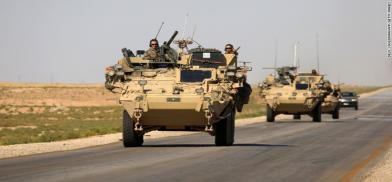Af-Pak region can become another Syria after US withdrawal
Trump ordering withdrawal of some troops is very much on the cards. The situation in Afghanistan over the next few months is unpredictable, with the internal turmoil and economic situation in Pakistan also deteriorating, writes Lt Gen Prakash Chand Katoch (retd) for South Asia Monitor

As has been the case with all US-Taliban rounds of talks, whether bilateral or multilateral, there is ambiguity about the outcome of the last round. There was no announcement despite the exuberance displayed by Zalmay Khalilzad, US Special Representative for Afghanistan Reconciliation; his usual concluding comment always has been that the talks were “useful” or “productive”.
The Taliban’s primary aim from day one is to see the end of American presence in Afghanistan. Therefore, before, during and after all the various rounds of talks, they have continued terror attacks in Afghanistan with full intensity, to worsen the situation. There have been conflicting reports; from the Taliban, stating differences with the US over troop withdrawal have been resolved, to reports that no US-Taliban deal has been agreed. The latter is more plausible, considering even a ceasefire is not acceptable to the Talban.
Unconfirmed reports quoting Taliban sources state that US troop withdrawal will be over 14 months, which possibly is keeping in mind that President Donald Trump is intent on withdrawal before the next US presidential election on November 3, 2020. But the quantum of troop withdrawal remains ambiguous. According to former General David H. Petraeus, “If the Trump administration orders a full pull-out from Afghanistan, there is considerably less doubt about what will happen — full-blown civil war and the re-establishment of a terrorist sanctuary as existed when the 9/11 attacks were planned there.”
For the present, US Army has not received any directions for withdrawing from Afghanistan. US troop withdrawal was Trump’s pre-election plank, but he has indicated some troops will remain in Afghanistan, implying that complete withdrawal is out.
The Taliban getting stronger by the day is not the only concern. Terror attacks by Islamic State are on the rise and apparently the western strategy of making the Taliban and Islamic State devour each other is not working out. That is why Trump wants India to fight the Islamic State in Afghanistan, saying, “Look, India is right there. They’re not fighting it; we’re fighting it. Pakistan is right next door. They’re fighting it very little – very, very little. It’s not fair.”
But Trump apparently forgot about “India is right here” when in the last four-party meeting on Afghan Peace Process in July 2019, Pakistan was included, but India was left out.
The situation in Afghanistan remains highly volatile, wracked frequently by terror attacks increasing in intensity. The Shia community remains a prime target; women and children included. Despite the charade, President Ashraf Ghani is hardly the favourite of Capitol Hill. Taliban shun Afghan government officials, calling them American puppets. Ghani is confident that next month’s election would give Afghanistan a stable government, but how effectively elections can be conducted in regions under Taliban control and influence, with Islamic State also increasingly undertaking terror attacks, remains questionable.
Trump ordering withdrawal of some troops is very much on the cards. The situation in Afghanistan over the next few months is unpredictable, with the internal turmoil and economic situation in Pakistan also deteriorating.
To Pakistan’s distress, the Taliban refused to conform to Pakistan’s stance of linking Kashmir with Afghanistan, Trump has indicated that complete US withdrawal from Afghanistan is not going to happen, and now FATF’s Asia Pacific Group (APG) has placed Pakistan in the ‘enhanced blacklist’ for failing to act on terror funding.
The Financial Action Task Force found Pakistan was non-compliant on 32 of the 40 compliance parametres of terror financing and money laundering. On 11 effectiveness parametres of terror financing and money laundering, Pakistan was adjudged low on 10. The triple whammy received by Pakistan is mirrored large on electronic media, on the face of Prime Minister Imran Khan.
To add to this are the clashes between the Punjab-dominated Pakistani military with the Pashtuns, Balochis and Sindhis, with continuing genocide in Balochistan, Waziristan and gunfire to quell Pashtun protests.
The coming months would likely see more instability in Af-Pak. Yet, China-backed Pakistan will continue to back and support Taliban plus renewed terrorism against India, particularly in Jammu and Kashmir. The danger of the Af-Pak region becoming like Syria in the event of US withdrawal is real, with Islamic State influence spreading to Central Asia also. That all this would threaten US interests, including on the US mainland, is unquestionable.
Trump’s unpredictability notwithstanding, recall his first televised speech from Fort Myers in August 2017 on his Af-Pak policy, wherein he was very direct in calling the bluff on Pakistan’s double game. Most significantly, he left future operations open ended, saying it is “counterproductive to announce dates intended to begin or end military options, numbers of troops or our plans for further military activities”.
Therefore, the permutations and combinations of US withdrawal from Afghanistan are endless. There could be spurts of withdrawal, peppered with increases depending on what the ground situation is and what suits Trump’s ‘America First’ policy.
(The author is Distinguished Fellow, United Service Institution of India. He can be contacted at prakashkatoch7@gmail.com)














Post a Comment